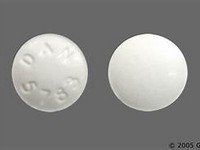Chlortalidone
CLINICAL USE
Thiazide-like diuretic:Hypertension Ascites Oedema Diabetes insipidus Mild to moderate heart failure
DOSE IN NORMAL RENAL FUNCTION
Hypertension: 25–50 mg daily Oedema: 50 mg daily initially Diabetes insipidus: 100 mg every 12 hours initially, reducing to 50 mg daily where possibleHeart failure: 25–50 mg daily increasing to 100–200 mg daily
PHARMACOKINETICS
DOSE IN RENAL IMPAIRMENT
GFR (mL/MIN)
30–50 Dose as in normal renal function <30 Avoid. See ‘Other Information’
DOSE IN PATIENTS UNDERGOING RENAL REPLACEMENT THERAPIES
IMPORTANT DRUG INTERACTIONS
Potentially hazardous interactions with other drugsAnalgesics: increased risk of nephrotoxicity with NSAIDs; antagonism of diuretic effectAnti-arrhythmics: hypokalaemia leads to increased cardiac toxicity; effects of lidocaine and mexiletine antagonisedAntibacterials: avoid administration with lymecyclineAntidepressants: increased risk of hypokalaemia with reboxetine; enhanced hypotensive effect with MAOIs; increased risk of postural hypotension with tricyclicsAnti-epileptics: increased risk of hyponatraemia with carbamazepineAntifungals: increased risk of hypokalaemia with amphotericinAntihypertensives: enhanced hypotensive effect; increased risk of first dose hypotension with post-synaptic alpha-blockers like prazosin; hypokalaemia increases risk of ventricular arrhythmias with sotalolAntipsychotics: hypokalaemia increases risk of ventricular arrhythmias with amisulpiride or sertindole; enhanced hypotensive effect with phenothiazines; hypokalaemia increases risk of ventricular arrhythmias with pimozide – avoid concomitant use. Atomoxetine: hypokalaemia increases risk of ventricular arrhythmiasCardiac glycosides: increased toxicity if hypokalaemia occursCiclosporin: increased risk of nephrotoxicity and hypomagnesaemiaLithium excretion reduced, increased toxicity
ADMINISTRATION
Reconstition
–
Route
Oral
Rate of Administration
–
Comments
A single dose at breakfast time is preferable
OTHER INFORMATION
Can precipitate diabetes mellitus and gout, and cause severe electrolyte disturbances and an increase in serum lipidsThiazide diuretics are unlikely to be of use once GFR<30 mL/min
